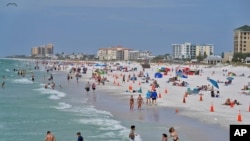As the Northern Hemisphere enters a second spring of the COVID-19 pandemic, experts are saying the higher temperatures and sunnier days are unlikely to do much on their own to curtail the spread of the virus.
Travel restrictions and mask mandates, along with people's behavior, have a much bigger impact than the weather, according to a new report from the World Meteorological Organization (WMO).
The report highlights that the steps people can take "far outweigh any external factors, and that's a really positive thing to know," said Dev Niyogi, geosciences professor at the University of Texas at Austin, who was not involved in the report but wrote a study published in November with similar findings.
“We saw waves of infection rise in warm seasons and warm regions in the first year of the pandemic, and there is no evidence that this couldn’t happen again in the coming year,” Ben Zaitchik, a climate scientist at Johns Hopkins University, said in a statement.
Panel to review information
Zaitchik chaired an interdisciplinary panel set up by the WMO to make sense of the deluge of research on the issue.
When the pandemic began in early 2020, the virus now called SARS-CoV-2 was known simply as the "novel coronavirus." Scientists could only look to other coronaviruses to guess how this one would behave.
Some coronaviruses cause common colds, which rise and fall with the seasons.
Scientists do not know exactly why that is, however, the report noted.
Some respiratory viruses do not survive as long in a warmer, more humid atmosphere compared with cold, dry winter air. Stronger summer sunlight may zap viruses more with ultraviolet (UV) radiation than on dimmer winter days.
In lab studies, SARS-CoV-2 did survive longer in cold, dry conditions with low UV light. But these studies did not show whether those conditions "have a meaningful influence on transmission rates under real-world conditions," the report said.
Affect of weather an unknown
One way the weather could affect how well the virus spreads is by affecting how people behave. Cold weather drives people indoors, where the virus is known to spread more easily. But hot weather and rain can also prompt people to go inside, the report noted.
The report also considered how air pollution affected COVID-19, but could not draw firm conclusions on the subject. Some early studies show higher death rates in more polluted air, but they have not been confirmed.
While the role of many of these environmental factors are still open questions, the report says the benefit of policies such as travel restrictions and mask mandates "has been clearly established."
Weather and air pollution levels are not a good basis for relaxing these measures, it added.
By highlighting how masks and social distancing are more powerful than the weather, the report shows that "for a change, our ability to be exposed or not (to a disease) is in our hands," Niyogi of the University of Texas said.




